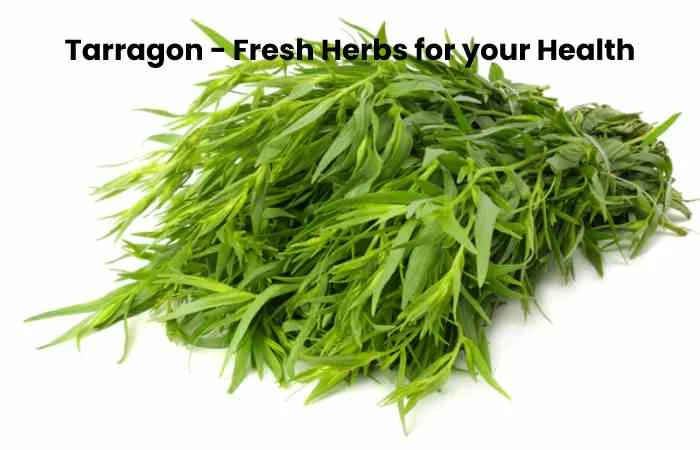Fresh Herbs for your Health: How do they taste, when to add them to the cooking process and what flavors go well with each other? With this guide to ten common fresh herbs (and a little help from our expert chefs), you’ll never again walk past the new herb stand at your local farmers market.
Table of Contents
1. Parsley
Although parsley looks strikingly similar to cilantro, the flavor is much milder. “Parsley has a fresh flavor that’s earthy and slightly sweet,” says Sara Haas, RDN, author of Taco! Tacos! Tacos! Parsley and cilantro look very similar, so opt for an herb with pointed leaves.
One cup of chopped parsley provides more than a thousand percent of your daily value of vitamin K, plus it’s rich in myricetin, a flavonoid that may have some anti-cancer properties. Haas suggests using parsley at the end of cooking to finish dishes. “It’s great in tabbouleh, baked potatoes, pasta, and grain dishes,” and goes great with salads and sandwiches, like this Spiced Chickpea Wrap.
2. Tarragon – Fresh Herbs for your Health

According to gourmet nutrition therapist Jackie Newgent, RDN, author of “The All-Natural Diabetes Cookbook,” and spokesman for the American Pecan Council, “tarragon has a bright, peppery but sweet flavour similar to anise.” “I honestly think it’s one of the most underutilised fresh herbs,” she says. Tarragon contains magnesium, iron, and zinc, but the amount used in cooking is usually relatively negligible.
Instead, Newgent recommends adding tarragon at the end of the cooking process or using fresh leaves. “One of my favorite picnic recipes is tarragon chicken salad with pecans because tarragon goes well with chicken, and pecans add a delicious texture to a creamy salad and are full of fiber.” For a dinner recipe, attempt this mushroom and white bean pasta over with tarragon.
3. Basil
The most popular fresh herb (probably because it’s a pizza topper), basil has a sweet, aromatic, and somewhat peppery flavor. Like other fresh herbs, it is rich in plant polyphenols, which remain considered to prevent chronic diseases. Not surprisingly, basil pairs well with Mediterranean flavors and works best when added at the end of cooking. It’s also an excellent addition to fresh salads, like this Spring Strawberry Salad.
4. Thyme
It remains often used at the end of recipes such as Braised Mushrooms with Thyme and Bulgur. According to Haas, thyme has a minty, earthy, lemony flavor with a hint of pine. In addition, thyme oil remains thought to have antimicrobial properties, and it is a reasonable basis for vitamin C. “Thyme is excessive for adding flavor to soups, broths and stews, roasted vegetables, and cooking beans from scratch,” says Haas.
Also Read: Healthy Habits Improve Your Overall Wellness
5. Rosemary
I always get thyme and rosemary confused, probably because the taste is quite similar. Rosemary can also remain described as lemony with a touch of pine, but it has a more woody flavor than thyme. The difference is that rosemary looks like a pine branch. It’s a good source of iron, calcium, and vitamin B6, and “research has shown that rosemary can prevent the formation of carcinogenic compounds during grilling,” says Haas. Rosemary remains best used in cooking or marinades, and the sprigs can remain used as skewers, as in this rosemary shrimp recipe.
6. Sage
Reminiscent of Thanksgiving, sage is synonymous with fall foods. A member of the mint family, “sage is slightly bitter and has a subtle sweetness with floral notes,” says Haas. It also contains flavonoids and polyphenolic compounds that serve as antioxidants. However, Haas cautions that sage is delicate, so it needs to remain used at the end of cooking. “It’s great in pasta, butter mixes, and desserts like this Cherry Crumble with Sage Brown Sugar.”
7. Coriander
Coriander is quite divisive because people either love it or hate it. “Cilantro tastes a little citrusy and sour, although some think it has an unusual soapiness,” says Newgent. “Cilantro is the Spanish version for the leaves of the coriander plant,” he adds. Newgent also recommends using cilantro in cold preparation, but not during cooking. “It goes well with Mexican, Asian, and Indian dishes, like this coconut cauliflower couscous,” notes Newgent.
8. Dill
One of the most underrated fresh herbs, dill, is used more often than you might realize – dill pickle or tzatziki sauce? Dill tastes both sweet and sour and has a citrus tinge. It’s a good source of calcium and iron, and the flavor goes well with almost any dish. Try using it on salads, baked potatoes, or savory baked goods like these hard-boiled egg cheddar muffins.
9. Oregano
“Oregano tastes like Italy if that country had taste!” says Newgent. “In other words, it’s a bit pungent, woody and bold with a sweet spiciness.” You’ve probably topped your pizza with dried oregano, but using fresh oregano is much rarer. It’s often too spicy to eat raw, so fresh oregano is best when used in the last 15 minutes of cooking, according to Newgent. After that, fresh oregano goes excellent with a pot of beans, a lemon marinade, or a simple marinara sauce.
10. Mint
Everyone knows what mint tastes like, thanks to toothpaste. But fresh mint has a more robust, sweeter, and earthier taste. Mint has long remained revered for its ability to heal stomach ailments, and research has even linked it to treating irritable bowel syndrome (IBS). Mint remains often used in Easter dishes and teas, but it also works great in a green smoothie.
Also Read: Digital Marketing Strategies That Work
Related posts
Featured Posts
Healthy Diet Tips to Avoid Missing Essential Nutrients
Tips for a Healthful Diet Maintaining a balanced diet can occasionally be more difficult said than done in the vibrant…
What is the Realty International Lifestyle?
Meet Lifestyle International Realty’s George CancioBello. George’s accomplishments as the Broker and Founder of Lifestyle International Realty serve as prime…


